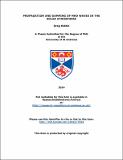Files in this item
Propagation and damping of MHD waves in the solar atmosphere
Item metadata
| dc.contributor.advisor | De Moortel, Ineke | |
| dc.contributor.author | Kiddie, Greg | |
| dc.coverage.spatial | 180 | en_US |
| dc.date.accessioned | 2015-07-28T14:12:14Z | |
| dc.date.available | 2015-07-28T14:12:14Z | |
| dc.date.issued | 2014-06-27 | |
| dc.identifier.uri | https://hdl.handle.net/10023/7054 | |
| dc.description.abstract | Quasi-periodic disturbances have been observed in the outer solar atmosphere for many years. Although first interpreted as upflows (Schrijver et al. (1999)), they have been widely regarded as slow magneto-acoustic waves, due to their observed velocities and periods. Here we conduct a detailed analysis of the velocities of these disturbances across several wavelengths using the Atmospheric Imaging Assembly (AIA) on board the Solar Dynamics Observatory (SDO). We analysed 41 examples, including both sunspot and non-sunspot regions of the Sun. We found that the velocities of propagating disturbances (PDs) located at sunspots are more likely to be temperature dependent, whereas the velocities of PDs at non-sunspot locations do not show a clear temperature dependence. This suggests an interpretation in terms of slow magneto-acoustic waves in sunspots but the nature of PDs in non-sunspot (plage) regions remains unclear. Finally, we found that removing the contribution due to the cooler ions in the 193 wavelength suggests that a substantial part of the 193 emission of sunspot PDs can be attributed to the cool component of 193. Phase mixing is a well known and studied phenomenon in the solar corona, to enhance the dissipation of Alfvén waves (Heyvaerts and Priest (1982)). In this study we run numerical simulations of a continuously driven Alfvén wave in a low beta plasma along a uniform magnetic field. We model phase mixing by introducing a density inhomogeneity. Thermal conduction is then added into the model in the form of Braginskii thermal conduction. This acts to transport heat along the magnetic field. A parameter study will be carried out to investigate how changing the density structure and other parameters changes the results. We go on to consider the effect of wave reflection on phase mixing. We found that wave reflection has no effect on the damping of Alfvén waves but increases the heat in the system. We also consider a more realistic experiment where we drive both boundaries and study how the loop is heated in this situation. We also study what effect changing the frequency of one of the drivers so there is a small difference between the frequencies (10%) and a large difference (50%). We find the general behaviour is similar, but the heat is tilted. We have investigated basic phase mixing model which incorporates the mass exchange between the corona and the chromosphere. Chromospheric evaporation is approximated by using a non dimensional version of the RTV (Rosner et al. (1978)) scaling laws, relating heating (by phase mixing of Alfvén waves), density and temperature. By combining this scaling law with our numerical MHD model for phase mixing of Alfvén waves, we investigate the modification of the density profile through the mass up flow. We find a rapid modification of the density profile, leading to drifting of the heating layers. We also find that similar results are own seen in the propagating Alfvén wave case when we incorporate the effects of reflection. | en_US |
| dc.language.iso | en | en_US |
| dc.publisher | University of St Andrews | |
| dc.rights | Creative Commons Attribution-NonCommercial-NoDerivatives 4.0 International | |
| dc.rights.uri | http://creativecommons.org/licenses/by-nc-nd/4.0/ | |
| dc.subject | MHD waves | en_US |
| dc.subject | Corona | en_US |
| dc.subject.lcc | QB539.M23K5 | |
| dc.subject.lcsh | Magnetohydrodynamic waves--Mathematical models | en_US |
| dc.subject.lcsh | Sun--Corona--Magnetic fields | en_US |
| dc.title | Propagation and damping of MHD waves in the solar atmosphere | en_US |
| dc.type | Thesis | en_US |
| dc.type.qualificationlevel | Doctoral | en_US |
| dc.type.qualificationname | PhD Doctor of Philosophy | en_US |
| dc.publisher.institution | The University of St Andrews | en_US |
This item appears in the following Collection(s)
Except where otherwise noted within the work, this item's licence for re-use is described as Creative Commons Attribution-NonCommercial-NoDerivatives 4.0 International
Items in the St Andrews Research Repository are protected by copyright, with all rights reserved, unless otherwise indicated.


